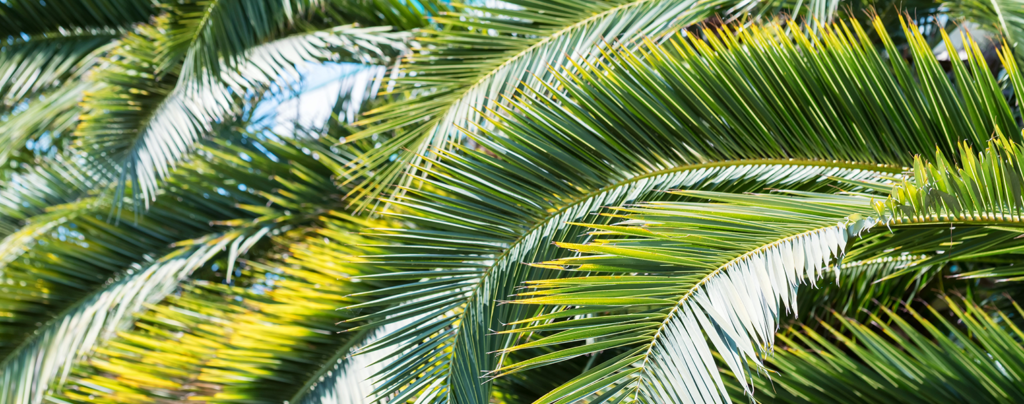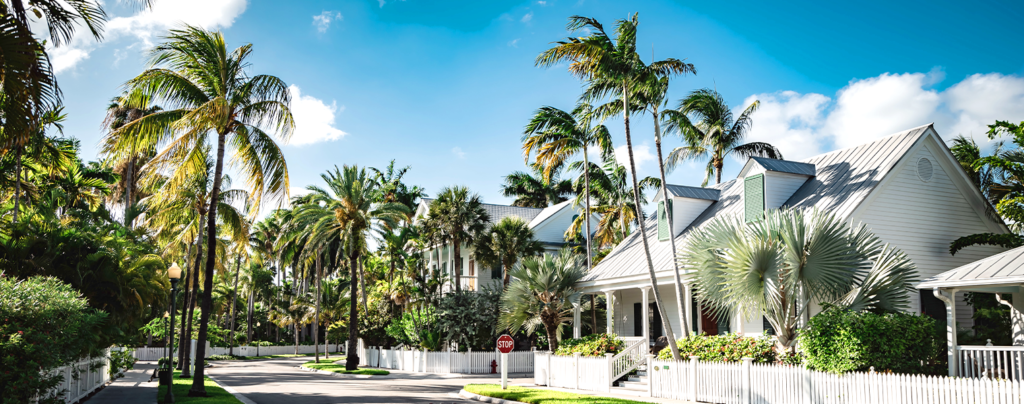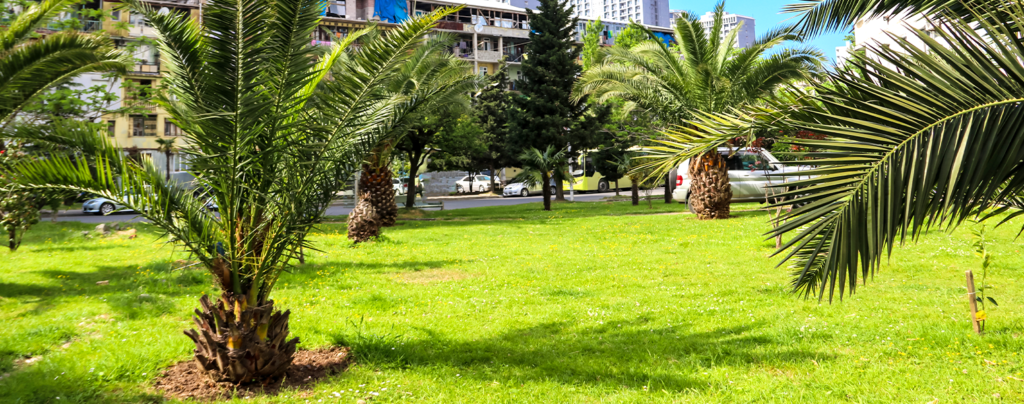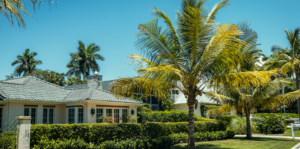Learning the ins and outs of palm tree planting and care is a must if you’re hoping to add palms to your landscape. Palm trees are one of the highlights of nature in Southern coastal areas, bringing that tropical vibe that instantly puts you in a “beach vacation” state of mind. Adding palm trees into your yard is a worthwhile investment in your property value, and they undoubtedly improve the view. In this article, you’ll find out how you can easily integrate these gorgeous trees into your landscape design.
The Basics Of Palm Tree Planting And Care
Want to give your yard a makeover with some new tropical trees? Here’s everything you’ll need to do to make sure your palm trees start on the right foot:
Planting your Palm
If you’re planting a smaller palm tree from a container, it shouldn’t be too difficult to do. However, there are some larger varieties that you may need help to plant. If you’re confident you can plant the tree you’ve selected, here’s how you can get it in the ground successfully:
- Dig a hole about 6″ deeper than the length of the tree’s root ball.
- Fill that extra 6″ up with a layer of sand.
- Place the palm’s root ball back into the hole, straighten the trunk, and pack the soil back down around to secure it in place, being careful not to layer very much soil over the top of the root ball or pile the soil up around the base of the trunk.
- Water the tree generously to ease the shock of transplantation.
While most palms are suited to being planted in this manner, there are a select few that can be buried more deeply. If you’re unsure of the specific planting instructions for your tree, feel free to call one of our experts, and we’ll give you the rundown.
It’s usually best to plant palm trees in Fort Lauderdale during late spring or early summer because the ground is nice and warm, and there’s frequent rain to help the roots establish. You’ll notice that they don’t grow very much for the first year or so, but there’s no need to worry. This is just because they direct most of their energy to the root system in these early stages, but they should have a growth spurt after a few years.
Sometimes, digging a circular moat a few feet around the base of the tree will help improve water uptake. If you don’t mind the look of the moat, it doesn’t hurt to take this extra step to help your palm’s roots develop during those first few years. That being said, one of the convenient things about palm trees is that they generally don’t have very invasive roots like other trees, so if you have any features like a swimming pool in your yard, you only have to space the tree about 6-10′ away.

Palm Tree Care: Watering And Maintenance
For those first three to four weeks after planting, you should try your best to water the tree every day. Take care not to over-water your palm—you only want to make sure the soil doesn’t get dried out from the sun. Next, for about three months, you’ll want to water it once a week. After that, you can slowly start to reduce the frequency of watering, and it will adjust to its environment.
If you’re going to use fertilizer, wait at least two months until after you plant your palm. When a palm tree gets put into the ground, it can shock their system a bit, and fertilizing too early can further agitate them. To be on the safe side, wait it out for those two months, and then sprinkle a slow-release fertilizer in a circle about 2′ away from the base. You can also try adding in some mycorrhizal fungi into the soil. Palm trees actually have a symbiotic relationship with this form of fungi, meaning both species benefit and thrive when they coexist together. The fungi bind to the roots of the palm tree, helping it to soak up extra nutrients and moisture and allowing it to grow bigger, healthier, and faster.

8 Palm Trees Available In Fort Lauderdale
We have an impressive variety of palms at Living Color. You’ll find palms in a wide range of sizes and shapes, depending on your preferences for landscape design. Different varieties have different preferences, too—while most are pretty resilient, there are some that can’t quite tolerate drought, and others that are a bit more sensitive to wet soils. If you live on the coast, there are a few varieties that can handle salt spray from the ocean. Here are the eight we have specially selected to carry at our store, as they are well suited to growing here in South Florida:
Christmas (Veitchia): Christmas palm care is pretty minimal—they’re a self-cleaning plant, so they drop their leaves naturally and don’t need pruning. They’re on the smaller side, so if you don’t have a sprawling property, this variety is a great pick. Its distinguishing feature is the bright red fruits that appear in fall and winter. If you plant a few of them close together, they’ll naturally curve outward, creating the appearance of one mega-tree. Occasionally, they may suffer from boron deficiency due to the poor, sandier soils of Florida, which results in small, malformed, or unopened leaves, and sideways growth. Adding a boron supplement to the soil should help the cause.
Foxtail (Wodyetia bifurcata): Foxtail palm care is quite minimal, as it is highly tolerant of a range of soils and can handle ocean spray like a champ, making it perfect for coastal properties. Just make sure the soil isn’t too acidic, and use a slow-release fertilizer instead of a water-soluble one.
Montgomery (Veitchia montgomeryana): This palm will reach up to 35′ high outdoors, but in its smaller stages, it can be grown in a container. Just watch out for spider mites if you bring it indoors! This is another specimen that doesn’t mind a little ocean spray, so feel free to plant it near the coast.
Coconut (Cocos nucifera): These guys are pretty hungry, so they need lots of water and lots of fertilizer, preferably with added nutrients like manganese, boron, and magnesium in addition to the regular nitrogen, phosphorous, and potassium.

Roebelenii (Phoenix roebelenii): Also called the Pygmy Date Palm, this dwarf variety can have single, double, or triple trunks, and a mophead of shaggy, glossy leaves that reach up to 12′ high. It produces white blossoms in the spring that will bear dark purple fruit.
Spindle (Hyophorbe lagenicaulis): The spindle palm has an elegant air about it, with long, arched fronds that catch the light beautifully. They are occasionally prone to magnesium deficiency, so a fertilizer with added magnesium supplements will help it out. To prevent mealybugs and scale, clean the leaves off occasionally with an alcohol wipe.
Alexander (Ptychosperma elegans): If you’ve got limited space, the narrow spread of the Alexander palm makes it an excellent option for smaller yards. They reach up to 25′ high, and while they prefer full sun, they’ll do just fine in partial, dappled shade. Fertilize your Alexander palm three times per year in spring, summer, and fall.
Coccothrinax (Coccothrinax barbadensis): You’ll be tempted to crack off one of the fan-shaped fronds from this lovely palm, which reaches a modest 15′ at full size. While it is a bit smaller, it’s a very fast grower, so you won’t have to wait around long for it to fill out.
If you’d like to add some palms to your landscape or grow some smaller varieties in containers at home, visit us at Living Color Garden Center! We’ll be happy to help set you up with the ideal variety to suit your needs. We’d also be pleased to answer any questions you may have about palm transplantation and care for those delicate first few months.
For another great tree to add to your landscape, check out our blog on caring for crepe myrtles!

